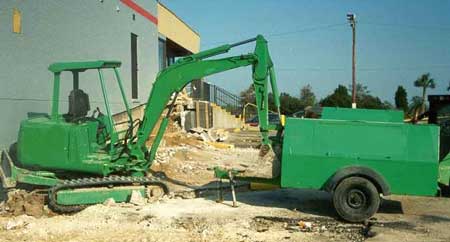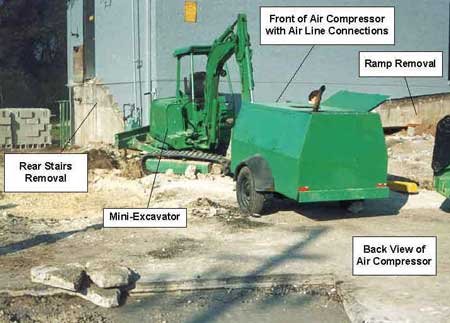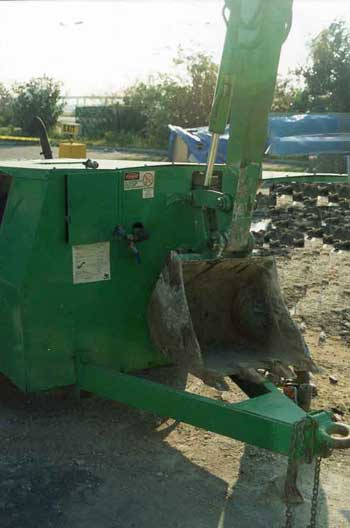Construction Laborer Dies After Being Pinned Between the Bucket of a Mini-Excavator and an Air Compressor – North Carolina
NIOSH In-house FACE Report 2000-10
Summary
A 43-year-old male construction laborer (the victim) died and a bystander was injured after they were pinned between the bucket of a mini-excavator and an air compressor. It was the victim’s first day at work for a masonry contractor whose crew was removing and replacing a wheelchair ramp leading up to the side entrance of a restaurant. According to the coroner’s report, just prior to the incident, the victim had taken a break from breaking up asphalt and concrete and was standing to the side watching the excavator operator remove debris. As he watched, the operator swung the excavator around and the excavator bucket struck an air line attached to an air compressor, pulling it loose. The air line tangled around the bucket. The victim, a coworker, and a bystander, who was a friend of the excavator operator, entered the area between the excavator and the air compressor to see what had happened. The bucket suddenly became disentangled and started to swing to the right. The operator moved the controls and the bucket moved back to the left toward the air compressor, pinning the victim and the bystander between the bucket and the compressor. Workers notified the general contractor, who was working inside the restaurant. He called 911 at 2:55 p.m. According to the police report, police and emergency medical services (EMS) personnel arrived at 2:59 p.m. EMS personnel immediately attended to the bystander, who had a scalp laceration, and then attended to the victim. EMS transported both individuals to a local hospital. The victim was admitted and emergency surgery was performed. Internal bleeding caused by compression injuries sustained in the incident could not be stopped and he died the following morning. The bystander was treated in the emergency room for a scalp laceration and released.
NIOSH investigators concluded that, to help prevent similar occurrences, employers should:
- provide workers with training in the recognition and avoidance of unsafe conditions and the required safe work practices that apply to their work environments
- ensure that equipment operators have been trained to use the equipment they are assigned to operate at the job site
Additional notes/recommendations:
- Rental companies should ensure that earth-moving equipment is functioning properly and that a manufacturer’s operator’s manual is supplied to customers at the time of rental.
Introduction
A 43-year-old male construction laborer (the victim) died and a bystander was injured after they were pinned between the bucket of a mini-excavator and an air compressor. On November 9, 1999, officials from the South Carolina Department of Labor, Office of Occupational Safety and Health notified the Division of Safety Research (DSR) of this fatality. On January 24, 2000, a DSR occupational safety and health specialist conducted an investigation of the incident. Personnel from the South Carolina Department of Labor, the city police department, and the county medical examiner’s office were interviewed. The employer and the victim’s coworkers had moved out of state and were not available for interview. The general contractor was not available for interview. Photographs of the incident site, a police report, and the coroner’s report were obtained during the course of the investigation.
The employer was a masonry contractor who had been in business for over 15 years and employed 7 people, including himself. The masonry crew at the site on the day of the incident included the excavator operator, who had worked for the company for 10 years and who had operated a mini-excavator 5 to 6 times over the last 2 years; a mason’s apprentice, who had worked for the company for 7 years; and the victim, who was working his first day for the employer. The employer was not present on the site and the general contractor was inside the restaurant when the incident occurred. According to the SC Department of Labor, the employer did not have records that showed evidence of a safety program or safety training. The incident occurred on the first day of work at the site. The job was to be completed in 4 days. According to SC Department of Labor records, this was the first fatality in the company’s history.
Back to Top
Investigation
The masonry contractor had been hired by a general contractor to remove and replace both a staircase leading to an exit door at the end of a restaurant and a wheelchair ramp located alongside the building leading to an entrance at the side of the restaurant. The victim and a coworker had been assigned to break up asphalt and concrete with pneumatic jack hammers. Another crew member, operating a mini-excavator, was digging up and moving the broken asphalt and concrete. All of the equipment – mini-excavator, air compressor, and jack hammers – had been rented by the general contractor for use by the masonry contractor and his crew.
The track-mounted mini-excavator used in the incident had a 10-foot, 9-inch digging depth and had a 23-inch-wide bucket attached (Photo 1). It was located between the restaurant and a towable air compressor. The left track of the excavator was approximately 12 feet from the side of the restaurant and the right track was approximately 6 feet from the body of the air compressor. The top of the air compressor, positioned on its cart, stood approximately 5 feet from the ground (chest height). It was approximately 3 feet wide and 6 feet long. Two air lines were connected to the air compressor and ran through the area in which the excavator was operating. One air line extended from the air compressor over the asphalt parking lot to the jackhammer used at the end of the building. The other airline ran to a jackhammer used near the side of the building where the wheel chair ramp was being replaced. The incident site layout is shown in Photo 2.
The three-man work crew began work at approximately 8 a.m. and took their lunch break at noon. After lunch, the victim and a coworker continued to break up asphalt and concrete. Sometime between 1:30 p.m. and 2:26 p.m., the victim and his coworker stopped working with the jack hammers and stood out of the way and to the side, as the mini-excavator operator dug up and moved the broken asphalt and concrete. A female bystander, who was a friend of the operator of the excavator, was also watching the work progress.
According to the coroner’s report, the operator swung the excavator around, and the excavator bucket struck an air line on the air compressor. The air line broke loose and tangled around the bucket. The victim, his coworker, and the bystander entered the area between the excavator and the air compressor to see what had happened. The bucket suddenly became disentangled and started to swing to the right. The operator moved the controls and the bucket moved back to the left, toward the air compressor pinning the bystander and then the victim between the bucket and the compressor (Photo 3). The excavator operator moved the bucket away to release them. The coworker, who had gone with them into the swing path but who had not been hurt, helped the victim walk to his truck and sit down. The victim was alert and told his coworker that his ribs hurt. The general contractor, who was in the restaurant, called 911 at 2:55 p.m. According to the police report, police and emergency medical services (EMS) personnel arrived at 2:59 p.m. EMS personnel attended immediately to the bystander, who had a scalp laceration, and then attended to the victim, who was sitting in his truck. EMS transported both individuals to a local hospital. While in the EMS truck, the victim became unresponsive, diaphoretic, and hemo dynamically unstable. The victim was admitted and emergency surgery was performed but internal bleeding caused by compression injuries could not be stopped. He died the following morning at 12:26 a.m., approximately 9 1/2 hours after the incident. The bystander was treated in the emergency room for a scalp laceration and released.
Back to Top
Cause of Death
The medical examiner listed the cause of death as exsanguination (internal bleeding) due to compression injury of chest and abdomen.
Recommendations and Discussion
Recommendation #1: Employers should provide all workers with training in the recognition and avoidance of unsafe conditions and in required safe work practices that apply to their work environments.
Discussion: According to 29 CFR 1926.21 (b)(2), “the employer shall instruct each employee in the recognition and avoidance of unsafe conditions and the regulations applicable to his work environment to control or eliminate any hazards or other exposure to injury or illness.” In this incident, the victim had not been provided with training in hazard recognition and avoidance and may have failed to recognize the hazards present when he walked into the swing path of the excavator. Hazard recognition and avoidance training may have helped the crew recognize that before they began work, they should have set up safety barriers around the swing pattern of the excavator and positioned air lines outside the reach of the excavator bucket. Training all workers to stay clear of all moving machinery and particularly out of the swing path of excavators, can help prevent workers from becoming injured or killed in machine-related incidents.
Recommendation #2: Employers should ensure that equipment operators have been trained to use the equipment they are assigned to operate at the job site.
Discussion: According to the SC Department of Labor report, the excavator operator had worked for the masonry company for the past 10 years and had operated excavators 5 or 6 times over the past 2 years. He normally worked as a mason. He had not operated the excavator used on the site prior to the day of the incident. Employers should ensure that their equipment operators have had operator training for the type of equipment they are to operate at the job site. This includes operator training for operation of equipment owned by the employer and for equipment obtained from a rental company. According to SC Department of Labor records, there was no operator’s manual at the job site for the excavator in use on the day of the incident. NIOSH investigators contacted the equipment rental agency that had rented the equipment to the general contractor, and found that they did not have an operator’s manual for the excavator. Employers should ensure that operator’s manuals are obtained with rental equipment. These manuals can be used to develop standard operating procedures and training in safe operation of the equipment.
During the course of the investigation, the operator’s manual for the mini-excavator used in the incident was obtained from a local distributor. The operator’s manual cautions all operators to read the manual before operating the machine and to follow all safety alerts provided. Among the warnings in the manual is that operators “make sure the area is clear of people before boom or unit swinging” and “make sure the area is clear of people before operating the bucket.”
Additionally, had equipment operator training been provided, it should have included manufacturer’s procedures to follow in the event of an obstruction, such as the air line entanglement. The procedure includes ensuring that the area is clear of people, and then lowering all attachments to the ground, stopping the engine, removing the key, and relieving hydraulic pressure by moving each control lever in all directions. Following the procedure, the operator could dismount the machine and remove the entanglement.
Additional Notes/Recommendations: Rental companies should ensure that earth moving equipment is functioning properly and that a manufacturer’s operator’s manual is supplied to customers at the time of rental.
Discussion: Rental companies should inspect their equipment prior to rental to ensure that equipment functions properly. Rental companies should provide an operator’s manual with each piece of equipment they rent. Rental agreements could be written to include a requirement that the rental company provide a demonstration of both the equipment’s safety features and safe operating procedures to workers who are assigned to operate the equipment.
Reference
Code of Federal Regulations 29 CFR 1926.21(b)(2), 2000 edition. U.S. Government Printing Office, Office of the Federal Register, Washington, D.C.
Investigator Information
This investigation was conducted by Doloris N. Higgins, Occupational Safety and Health Specialist, NIOSH Division of Safety Research, Surveillance and Field Investigation Branch, Fatality Assessment and Control Evaluation Team.
Back to Top
Photographs



